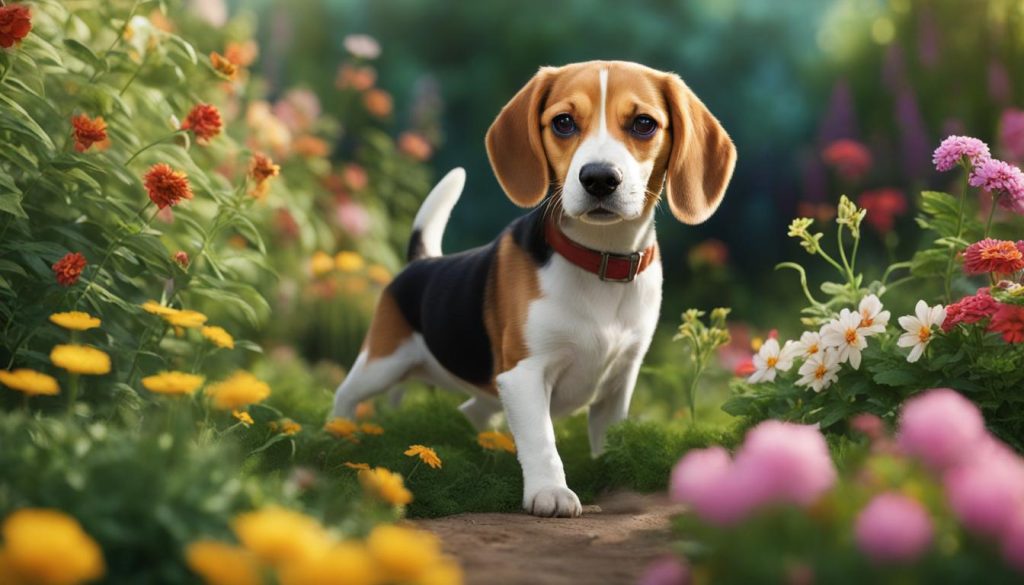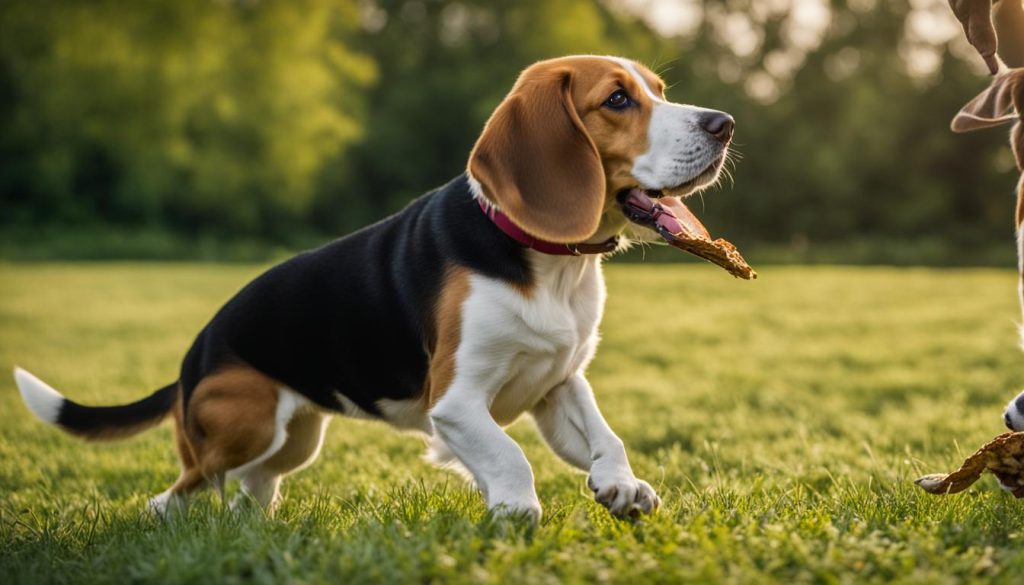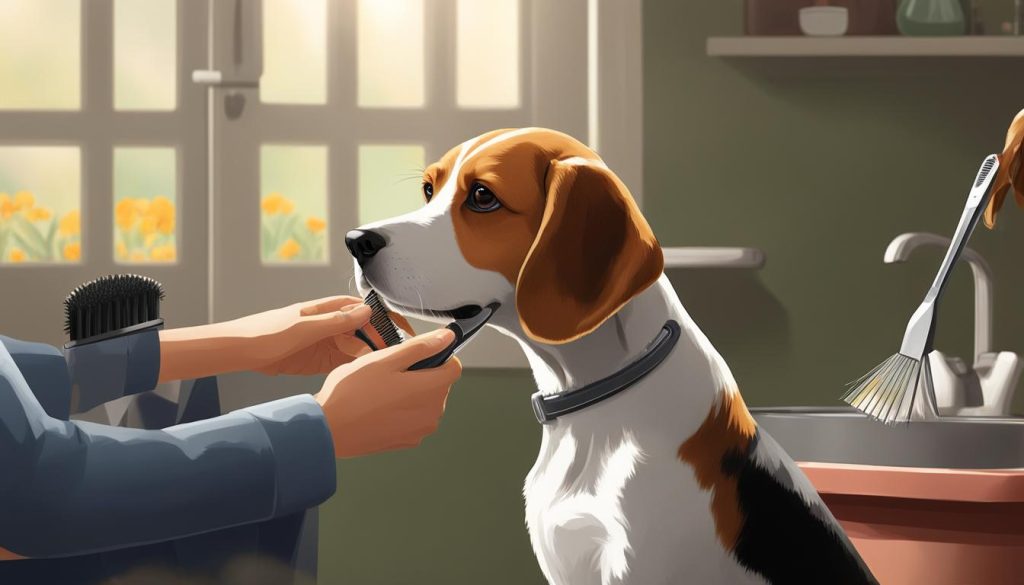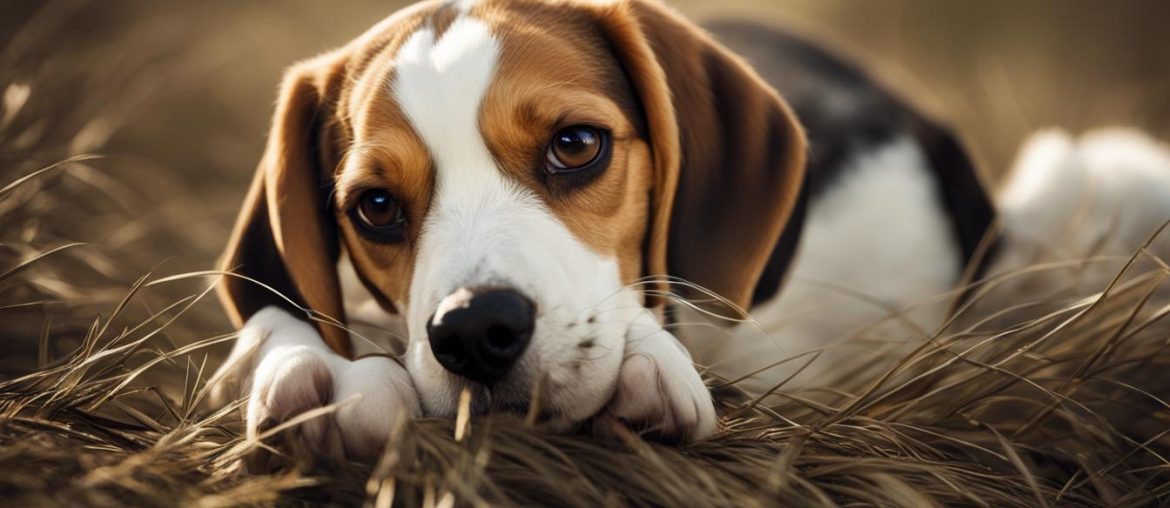Welcome to the world of beagles! In this article, we will explore the captivating characteristics of the Beagle Dog Breed, including their physical traits, personalities, exercise needs, and training requirements. Whether you’re a seasoned Beagle enthusiast or new to the breed, there’s something here for everyone.
Key Takeaways
- Beagles are a charming and captivating dog breed known for their unique characteristics.
- They have a compact size, expressive eyes, and long, droopy ears that contribute to their keen sense of smell.
- Beagles have a friendly and playful personality, making them great companions for families and other pets.
- Regular exercise, both physical and mental, is crucial to keep Beagles happy and healthy.
- Training Beagles requires consistency, positive reinforcement, and early socialization for well-behaved behavior.
Beagle Physical Characteristics
When it comes to physical characteristics, Beagles have some unique and charming features that set them apart. Standing at around 13 to 15 inches tall at the shoulder, these dogs have a compact stature that makes them easily recognizable. Their expressive eyes and long, droopy ears not only add to their adorable appearance but also serve a purpose – enhancing their keen sense of smell.
Beagles sport a short, low-maintenance coat that comes in a variety of colors. From classic tricolor combinations to lemon or red and white variations, there is a spectrum of hues to choose from. Their coat requires only occasional brushing to keep it tidy and free of loose hair.
One of the most distinguishing features of a Beagle is their ears. The long, droopy ears not only contribute to their iconic look but also help to funnel scents toward their nose, making them excellent scent hounds. This trait is essential for their hunting past and adds to their inquisitive nature as natural explorers.
Beagles have a compact stature, expressive eyes, long, droopy ears, and a short, low-maintenance coat that comes in various colors.

| Physical Characteristics | Description |
|---|---|
| Size | Approximately 13 to 15 inches tall at the shoulder |
| Coat | Short, low-maintenance, available in various colors |
| Ears | Long and droopy, contributing to their keen sense of smell |
Beagle Personality
The Beagle Dog Breed is known for its vibrant personality and playful nature. They are curious and always ready for adventure, making them an ideal choice for active individuals or families. Beagles are friendly and social, getting along well with children and other pets. Their amiable disposition makes them an excellent addition to any household.
One of the standout characteristics of Beagles is their inquisitive nose. They are natural scent hounds and have an exceptional sense of smell. This innate ability makes them skilled trackers and explorers. Beagles love to follow their nose, which can sometimes lead them on exciting and unexpected endeavors. I recommend that you keep them on a leash or in a secure area to prevent them from wandering off.
Beagles are intelligent dogs that thrive on mental stimulation. They enjoy interactive games and puzzles that challenge their minds. Engaging in activities that provide mental stimulation is essential for their overall well-being. Training sessions can also be a great way to mentally stimulate a Beagle while reinforcing good behavior and obedience.

When it comes to temperament, Beagles are generally affectionate and loyal. They form strong bonds with their human companions and are known for their gentle and patient nature. However, Beagles can be strong-willed at times and may require consistent training and positive reinforcement to ensure they understand and follow commands.
In summary, the Beagle Dog Breed possesses a vibrant and friendly personality. Their inquisitive nature, intelligence, and loyalty make them wonderful companions for individuals or families who enjoy an active lifestyle and are looking for a playful and affectionate four-legged friend.
Beagle Exercise
Exercise is a vital aspect of caring for a Beagle. These energetic dogs require regular physical activity to stay happy and healthy. Daily walks are essential for their well-being and should last between 30 to 60 minutes. Not only do walks help to burn off excess energy, but they also provide mental stimulation as your Beagle explores their surroundings and follows their curious nose.
In addition to walks, provide your Beagle with mental stimulation. Beagles are intelligent dogs that thrive when their minds are engaged. Interactive toys, puzzle games, and training sessions are excellent ways to keep their minds sharp and prevent boredom. Beagles also love playtime and enjoy games of fetch and agility exercises. These activities not only provide physical exercise but also strengthen the bond between you and your furry friend.
H3: Playtime Ideas for Beagles
- Hide and seek: Hide treats or toys around the house or yard for your Beagle to find.
- Tug-of-war: Engage in a friendly game of tug-of-war using a sturdy rope toy.
- Obstacle course: Set up a small obstacle course with tunnels, jumps, and ramps for your Beagle to navigate.
- Scent games: Hide treats or toys and let your Beagle use their incredible sense of smell to find them.
Try to always monitor your Beagle’s exercise intensity and adjust accordingly. While they have plenty of energy to burn, be mindful of their limits, especially during hot weather. Keep them hydrated and provide plenty of breaks during exercise sessions. With the right balance of physical and mental exercise, your Beagle will thrive and be a happy, content companion.

Beagle Training
Training is an essential aspect of raising a well-behaved and obedient Beagle. With their intelligence and willingness to please, Beagles can be trained effectively using positive reinforcement methods. This approach focuses on rewarding desired behaviors rather than punishing unwanted ones. Positive reinforcement includes treats, praise, and affection as rewards for good behavior.
Socialization is another key component of Beagle training. Introducing your Beagle to different people, animals, and environments from an early age helps them develop confidence and adaptability. Regular exposure to new experiences ensures that your Beagle grows up to be a well-rounded and well-adjusted companion.
When training your Beagle, keep sessions short, fun, and engaging. Beagles have a naturally curious nature, so incorporating interactive games and training exercises into the sessions will keep them stimulated and focused. Consistency is also crucial in training, as it helps reinforce desired behaviors and prevents confusion.
Training Tips for Beagles:
- Start training your Beagle as early as possible to establish good habits and behaviors.
- Use positive reinforcement techniques, such as treats and praise, to reward desired behaviors.
- Keep training sessions short and engaging to maintain your Beagle’s interest and attention.
- Focus on socialization to ensure your Beagle is comfortable and friendly around other people and animals.
- Be patient and consistent in your training efforts, as it may take time for your Beagle to fully grasp and comply with commands.
To put it simply, training is an ongoing process that requires dedication and patience. With consistent effort and positive reinforcement, your Beagle will become a well-behaved and obedient companion.

Table: Comparison of Beagle Training Methods
| Training Method | Advantages | Disadvantages |
|---|---|---|
| Positive Reinforcement | – Creates a positive association with training – Builds a strong bond between owner and Beagle – Encourages desired behaviors |
– Requires consistency and patience – May not be effective for all Beagles – Can be time-consuming |
| Clicker Training | – Provides immediate feedback – Helps mark desired behaviors – Can be used for complex commands |
– Requires additional tools (clicker) – Initial training required for both owner and Beagle – May not be suitable for all Beagles |
| Behavioral Training | – Addresses specific behavior issues – Helps modify unwanted behaviors – Tailored approach to individual Beagle’s needs |
– Requires professional guidance in some cases – Can be more expensive – May take longer to see results |
History and Origin of Beagles
Welcome to the intriguing world of Beagles, where history and charm intersect. The Beagle breed boasts a rich heritage that can be traced back to Roman times. These dogs were originally bred for hunting small game, making use of their exceptional sense of smell and compact size. In fact, the name “Beagle” is believed to have originated from the Old French word “beigh,” which means “to open,” referencing their distinctive howling bark.
| Beagles in Roman Times | |
|---|---|
| The Romans valued Beagles for their hunting abilities and often used them to track down rabbits and other small game. These loyal and tenacious dogs played a crucial role in providing sustenance for their human companions. |  |
“Beagles have a fascinating history that dates back to Roman times.”
Over the centuries, Beagles have evolved, adapting to the changing needs and preferences of their human counterparts. Their hunting prowess and friendly nature made them popular choices for both aristocrats and common folk alike. Beagles continued to play an important role in hunting throughout Europe, and their reputation as skilled scent hounds spread far and wide.
Beagles as Hunting Dogs
Beagles’ exceptional sense of smell and their ability to track scents for long distances made them invaluable assets as hunting dogs. They were particularly renowned for their prowess in hunting rabbits, hares, and other small game. The Beagle’s compact size and agile physique allowed them to maneuver through dense undergrowth with ease, never losing sight of their prey.
- Beagles are known for their exceptional sense of smell
- They were highly valued for their hunting abilities
- Their compact size and agility made them well-suited to navigate various terrains
- Beagles played a crucial role in hunting rabbits, hares, and other small game
Today, while Beagles may not be as widely used for hunting, their historical significance as skilled hunters is still highly regarded. They have transitioned into beloved family pets, captivating hearts with their affable nature and charming personality. The Beagle’s journey throughout history serves as a testament to their enduring appeal and the deep bond they form with humans.
Now that we’ve delved into the captivating history and origin of Beagles, it’s time to explore key considerations before welcoming one into your home. Section 7 will provide important insights into lifestyle compatibility, space requirements, time commitment, training, and healthcare needs when owning a Beagle.
Key Considerations Before Getting a Beagle as a Pet
Before deciding to bring a Beagle into your home, there are several key considerations to keep in mind. Ensuring a good lifestyle match, providing adequate space, dedicating time for training and socialization, and understanding the healthcare needs of a Beagle are all important factors to evaluate.
Lifestyle Match
Beagles are energetic and social dogs that require an active lifestyle. If you lead a sedentary life or are unable to provide them with regular exercise and mental stimulation, a Beagle may not be the best fit for you. They thrive in homes where they can participate in outdoor activities, such as long walks, play sessions, and training exercises. Their sociable nature also means they may struggle if left alone for extended periods, so consider your availability and ability to meet their social needs.
Space Requirements
Beagles are relatively small in size, but they have a lot of energy to burn. They need space to roam and explore, so a house with a fenced yard or access to nearby parks is ideal. Apartment living can work if you are committed to providing them with ample exercise and playtime outside of the home. However, Beagles have a tendency to bark, so you need to consider the noise tolerance of your neighbors.
Time Commitment
Beagles are intelligent and require mental stimulation, training, and socialization to keep them happy and well-behaved. This means committing time each day for training sessions, interactive play, and social outings. Training a Beagle requires consistency, patience, and positive reinforcement. If you have a busy schedule or are not able to dedicate time to their needs, it may be best to reconsider getting a Beagle.
Training and Healthcare
Beagles are trainable dogs, but they can be stubborn at times. Consistent and positive reinforcement-based training methods work best with this breed. Socialization from an early age is crucial to help them become well-adjusted and friendly around people and other animals. Additionally, Beagles may be prone to certain health issues, such as obesity and ear infections, so regular veterinary care and proper grooming are essential for their well-being.
To put it simply, owning a Beagle is a long-term commitment, as they can live for 12 to 15 years or even longer. By carefully considering these key factors, you can ensure that you are prepared to provide a loving and suitable home for a Beagle.

Grooming a Beagle
Proper grooming is an essential part of caring for your Beagle. Regular grooming not only keeps them looking their best but also helps maintain their overall hygiene and health. Here are some key aspects to consider when it comes to grooming your Beagle:
Brushing:
Beagles have short coats that require minimal grooming. However, regular brushing helps remove loose hair and keep their coat shiny. Use a soft-bristle brush or a grooming mitt to gently brush your Beagle’s coat once or twice a week. This not only helps in removing excess hair but also stimulates the skin and promotes good blood circulation.
Bathing:
Beagles are generally clean dogs and do not require frequent baths. Aim to bathe your Beagle every 6-8 weeks or as needed, using a mild dog shampoo. Before bathing, brush your Beagle’s coat to remove any tangles or mats. During the bath, ensure you thoroughly rinse off all the shampoo to prevent skin irritation. After the bath, dry your Beagle completely to prevent dampness that may lead to skin problems.
Nail Trimming:
Regular nail trimming is important to prevent overgrowth and discomfort for your Beagle. Trim your Beagle’s nails every 2-4 weeks or as needed. Be cautious when trimming, ensuring you do not cut into the quick, which is the sensitive part of the nail. If you are unsure, it is advisable to seek assistance from a professional groomer or veterinarian.
Ear Care:
Beagles are prone to ear infections, so regular ear care is crucial. Check your Beagle’s ears weekly for any signs of redness, swelling, or discharge. Clean their ears using a dog-specific ear cleaner and cotton balls or pads. Gently wipe the outer part of the ear, avoiding inserting anything into the ear canal. If you notice any abnormalities or persistent issues, consult your veterinarian for further guidance.
Dental Hygiene:
Beagle dental hygiene is essential for their overall health. Establish a routine of brushing your Beagle’s teeth a few times a week using a dog-specific toothbrush and toothpaste. Regular brushing helps prevent plaque buildup, tartar formation, and other dental issues. Additionally, provide your Beagle with dental chews or toys that promote oral health and help keep their teeth clean.
| Grooming Task | Frequency |
|---|---|
| Brushing | Once or twice a week |
| Bathing | Every 6-8 weeks or as needed |
| Nail Trimming | Every 2-4 weeks or as needed |
| Ear Care | Weekly |
| Dental Hygiene | A few times a week |
By following a regular grooming routine and paying attention to their specific needs, you can ensure that your Beagle stays comfortable, healthy, and well-groomed.

Beagle Dietary Requirements
When it comes to taking care of your Beagle, providing the right diet is essential for their overall health and well-being. Understanding the dietary requirements of this breed is crucial to ensure that they receive the proper nutrition they need. Here are some key considerations to keep in mind:
- Beagle Dog Food: Choose a high-quality dog food brand that is specifically formulated for Beagles. Look for a product that lists meat as the primary ingredient, as this will provide them with the necessary protein for muscle development.
- Portion Control: Beagles have a hearty appetite, but practice portion control to prevent weight gain. Consult with your veterinarian to determine the appropriate portion size based on your Beagle’s age, weight, and activity level.
- Feeding Schedule: Establish a regular feeding schedule for your Beagle. Dividing their daily portion into two or three meals can help regulate their metabolism and prevent digestive issues. Stick to a consistent schedule to promote healthy eating habits.
- Water Intake: Ensure that your Beagle has access to clean and fresh water at all times. Hydration is crucial for their overall health and helps support their digestion and circulation.
By following these dietary guidelines, you can help keep your Beagle healthy and happy throughout their life. Try to monitor their body condition and consult with your veterinarian for any specific dietary recommendations based on your Beagle’s individual needs.
Now, let’s take a closer look at the nutritional content of some common dog food brands specially formulated for Beagles:
| Brand | Protein Content | Fat Content | Recommended Serving Size |
|---|---|---|---|
| Brand A | 25% | 10% | 1 cup/day |
| Brand B | 23% | 12% | 1.5 cups/day |
| Brand C | 20% | 15% | 2 cups/day |
These are just a few examples, and consult with your veterinarian for personalized recommendations based on your Beagle’s specific needs and dietary preferences. To put it simply, the nutritional requirements of Beagles may vary depending on factors such as age, activity level, and overall health.
Final Thoughts
To sum it up, the Beagle Dog Breed is truly one-of-a-kind, and it’s no wonder why they are beloved by dog enthusiasts around the world. With their captivating physical traits, including expressive eyes and long, droopy ears, Beagles have an undeniable charm that is hard to resist.
But it’s not just their looks that make them special. Beagles possess a vibrant personality, characterized by their playful and friendly nature. They are curious and social, making them excellent companions for both children and other pets.
Beagles also have a rich history as hunting dogs, dating back to Roman times. Over the centuries, they have evolved into the loving and loyal pets we know today. Their exceptional sense of smell and compact size make them natural explorers and skilled scent hounds.
Whether you’re looking for a playful and friendly family pet or a companion for outdoor adventures, the Beagle Dog Breed offers a unique blend of qualities that will bring joy and companionship to your life. Consider welcoming a Beagle into your home, and experience the love and devotion that this pretty good breed has to offer.
FAQ
What are the physical characteristics of Beagles?
Beagles have a compact stature, measuring around 13 to 15 inches tall at the shoulder. They have expressive eyes and long, droopy ears. Their short coat comes in various colors, including tricolor combinations and lemon or red and white variations.
What is the personality of Beagles like?
Beagles have a vibrant personality. They are curious, playful, and friendly. They get along well with children and other pets. Beagles are also skilled scent hounds and natural explorers.
How much exercise do Beagles need?
Beagles are energetic dogs that require regular exercise. Daily walks of at least 30 to 60 minutes are essential. Mental stimulation through interactive toys, puzzle games, and training sessions is also important.
Are Beagles easy to train?
Yes, Beagles are intelligent and eager to please, making them trainable companions. Consistency and positive reinforcement are key when training Beagles. Starting training and socialization from a young age is important.
What is the history and origin of Beagles?
Beagles have a fascinating history that dates back to Roman times. They were originally bred for hunting small game. The name “Beagle” is believed to originate from the Old French word “beigh,” meaning “to open,” referencing their howling bark.
What should I consider before getting a Beagle as a pet?
Before getting a Beagle, ensure that your lifestyle matches their energetic nature. Provide enough space for their playful antics and dedicate time for socialization and training. Be prepared for routine veterinary care.
How do I groom a Beagle?
Grooming a Beagle is relatively low-maintenance. Regular brushing and occasional bathing are recommended. Nail trimming, ear cleaning, and teeth brushing are also important for their hygiene and health.
What are the dietary requirements for Beagles?
Beagles have straightforward dietary needs. Choose a high-quality dog food brand that lists meat as the primary ingredient. Portion control is crucial to prevent weight gain, and a regular feeding schedule helps regulate their metabolism.






